
|
 |

|
|---|
COLLIERS ENCYCLOPEDIA
[1955 Edition] - subsection on Drug Addiction
"MARIJUANA, the North American homologue of hashish or Indian hemp, has gained in popularity among addicts, particularly during World War II. Its relative cheapness, the fact that the plant flourishes anywhere in the United States from open fields to window boxes, the case with which it can be used as a smoke (rather than the painful, possible infective, and expensive hypodermic), and its allegedly stimulating effects all account for its usage. Another physiological phenomenon is the relative harmlessness, other than photophobia (pathological sensitivity of the eyes to light) which accounts for so many marijuana addicts constantly wearing dark glasses. Other than this, none of the ravages to health, such as are common in morphineism are encountered. A certain amount of eventual depravity and some depression may be found, but how much of this constitutes overt expressions of the original personality cannot be gauged. After two or three cigarettes, the addicts experiences decreased power to control his actions and thoughts; the mental confusion is followed by euphoria, a feeling of increased power and ability. Illusions are common, as are pleasing, fanciful hallucinations. Disorientation and delirium may ensue. Under the influence of marijuana violent acts have been committed, including homicide, sexual orgies, and gruesome sadistic acts."
THE NEW PICTORIAL ENCYCLOPEDIA OF THE WORLD
[1954 Edition] By Pictorial Encyclopedia, Inc. New York, N.Y.
"MARIHUANA or MARIJUANA, a drug derived from the flowers of the Indian hemp, Cannabis sativa. Its effects are immediate stimulation followed by depression and a loss of the sense of time and distance. It is rarely used in medicine but is sold illicitly, particularly in the U.S., in the form of cigarettes. Although the harmful effects and habit-forming properties of marihuana are not so great as those of some other drugs, the use of marihuana tends to lead to the use of such highly addictive drugs as heroin and morphine."
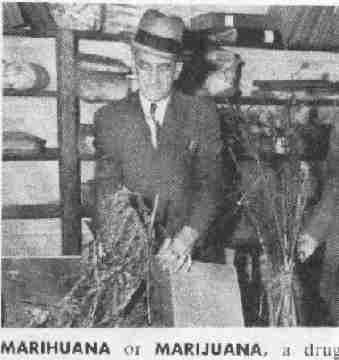 Medical Marihuana is Evil |
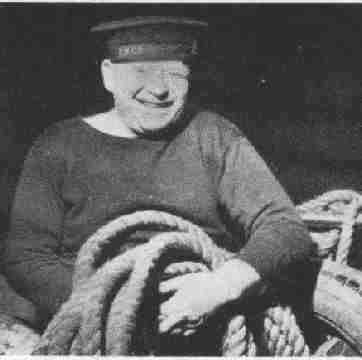 Industrial Hemp is Good |
"HEMP, a plant of the genus Cannabis, of which C. sativa is the only known species. It is an annual herbaceous plant, the fiber of which constitutes the hemp of commerce. It is a native of W. and CENT. Asia, but has been long naturalized in Brazil and tropical Africa, and is extensively cultivated in many countries. The Indian variety, often called Cannabis Indica, is the source of the narcotic drug bhang or hashish. Hemp fiber, obtained from the skin or rind by rotting the stalks under moisture, is prepared by various processes for manufacturing uses. It is tough and strong, and well adapted for weaving into coarse fabrics such as sailcloth, and twisting into ropes and cables."
THE UNIVERSAL STANDARD ENCYCLOPEDIA
[1955 Edition] Standard Reference works publishing Co. Inc.
MARIJUANA drug composed of the dried inflorescences of Cannabis sativa, the common hemp (q.v.), native to Asia and naturalized throughout tropical and temperate regions of the world. The inflorescences contain a hypnotic resin, called cannabin, and an essential oil. The drug is smoked by addicts in the form of cigarettes. Marijuana has an extensive effect on the nervous system, but its habit-forming properties, are a matter of controversy among physicians. Moderate or small doses of the drug are stimulant in the early stages following administration, but act as a depressant in later stages. Marijuana causes dilation of the pupils of the eyes, general depression of the sense of touch, and reduction of pain. It also tends to cause a semiconscious mental condition resulting in loss of power to judge time and distance, and produces a feeling of well-being which often impels the user to perform senseless acts. In later stages, the drug produces drowsiness, followed by sleep. Moderate amounts of marijuana do not produce unpleasant aftereffects. Excessive amounts of marijuana are rarely fatal, but may cause semipermanent depression of respiratory and circulatory functions. Compare CANNABIS.
THE BOOK OF POPULAR SCIENCE
[1959 Edition] - The GROLIER Society Inc.
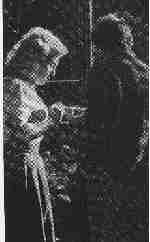
A Disturbing Problem of Our Modern Civilization - By Milton Lewis
THE word "drug" is generally applied to any substance used as a medicine or in making medicine. Aspirin, which alleviates pain and helps lower body temperature, and quinine, used in the prevention and treatment of malaria, are drugs; so are the sulfonamides (sulfa drugs) and the antibiotics, which have revolutionized medical practice and saved countless lives. Certain drugs, however, are taken not as medicines, but to satisfy a craving that has become an ingrained habit. These habit-forming drugs have brought misery to millions in every quarter of the globe.
Habit-forming drugs fall into two main groups: stimulants, or excitants, and sedatives, also known as depressants. The stimulant drugs excite the nervous system and keep the user alert, at least for a time; they include cocaine, marijuana and Benzedrine. . . .
In this chapter we shall deal with some of the more important excitants and depressants listed as narcotics. We shall consider the sources of these drugs and their effects upon their victims.
The EFFECTS OF STIMULANT DRUGS
. . . The stimulant known as marijuana, or marihuana, in North and South America, is derived from the hemp plant, Cannabis sativa. The fibers of this plant are used in making rope and cord; the seed is an ingredient in bird-feed mixtures. The habit-forming drug is derived from a resinous substance in the flowers and leaves of the plant.
One of the earliest stimulants derived from the hemp plant was hashish. The word "assassin" comes from hashish. At the time of the Crusades a Mohammedan sect committed secret murders while under the influence of hashish; they came to be known as hashshashin, or men addicted to hashish. The word hashshashin, transformed to "assassin," later came to refer to any hired or appointed murderer. Hashish is still used, particularly in the Middle East.
Marijuana is really a kind of hashish, in less concentrated form. It is sometimes taken by mouth; generally, however, it is prepared in the form of cigarettes, called "reefers," made by mixing tobacco with crushed hemp leaves. Most of the marijuana sold in the United States comes into the country illegally from Mexico; a considerable quantity, however, is prepared from plants grown in the United States. As a matter of fact, Cannabis sativa often flourishes unnoticed in vacant lots and along roadsides. The cultivation of the plant is not permitted in the United States. The medical profession does not use it in any form.
Marijuana cigarettes look homemade; they are sometimes wrapped in brown paper. When lighted, they have a distinct and unforgettable, smell. Marijuana produces a sort of composite effect. It acts on the higher functions of the brain in the same way that alcohol does. It serves as a depressant on the inhibitory functions; in other words, it releases the brakes of restraint. It also acts as a powerful stimulant. A curious effect of the drug is to make the user unduly sensitive to light; many marijuana addicts wear dark glasses.
 The drug may produce a temporary sense of grandeur, increased strength and pleasure. It may also bring about a feeling of panic and anxiety, especially when taken in large doses. At this stage, the user may run amuck and even commit murder in what he supposes is self-defense. However, such extreme cases generally occur only when a concentrated dose has been taken. The repeated use of marijuana leads to dullness, mental lassitude and the destruction of will power. The Arab slave traders of other times were familiar with this effect of drugs derived from the hemp plant; they used them to make their slaves more docile.
The drug may produce a temporary sense of grandeur, increased strength and pleasure. It may also bring about a feeling of panic and anxiety, especially when taken in large doses. At this stage, the user may run amuck and even commit murder in what he supposes is self-defense. However, such extreme cases generally occur only when a concentrated dose has been taken. The repeated use of marijuana leads to dullness, mental lassitude and the destruction of will power. The Arab slave traders of other times were familiar with this effect of drugs derived from the hemp plant; they used them to make their slaves more docile.
The use of marijuana paves the way for addiction to more dangerous drugs. The smoker of "reefers" is apt to come in contact with a "dope pusher" --- a seller of illicit drugs ---who urges the smoker to try a more potent drug, such as heroin. . . .
IS THERE A CURE FOR THE DRUG HABIT?
The only infallible "cure" for the narcotic-drug habit is not to fall victim to it in the first place. Therefore prevention is the chief objective of those who combat the evil. In any preventive program, it is vital to control the cultivation of the plants that yield potentially dangerous drugs; it is just as important to regulate the manufacture and distribution of these drugs. Various attempts have been made to draw up international agreements that would be binding on all nations; but these measures have met with only moderate success.
. . . Various methods have been employed to stem the flow of illicit drugs. Drug education programs have been launched. Federal agents (sometimes acting in cooperation with foreign police) and local authorities have broken up smuggling rings. Peddlers of drugs have been imprisoned and fined. There have been conflicting reports about the success of these measures.
. . . Certain authorities have proposed what they consider to be a realistic approach to the problem of recidivism, or backsliding. They would set up a controlled medical-care program, under which addicts would continue to get as much of the addicting drug as they needed, while they were being treated. If treatment failed and the victim continued to use the drug, it would be supplied to him in a "drug clinic" at a cost in pennies (which is what such drugs are really worth). According to the advocates of this clinic plan, it would keep the addict from going to the underworld to purchase drugs or from committing crimes in order to pay the high prices that are asked.
Most law-enforcement officials, however, regard this clinic method of treating the drug problem with abhorrence. They point out that a similar plan was tried out in 1920 and failed miserably. Harry J. Anslinger, United States Commissioner of Narcotics, condemned the plan as preposterous. He pointed out that if addicts were to obtain their favorite drugs for pennies in clinics, it would be only fair to provide other clinics where alcoholics could buy intoxicants at low prices. --- See also Vol. 10, P. 278: "Narcotics."
FUNK & WAGNALL
New Practical Standard Dictionary [1954]
Marihuana The hemp plant (Cannabis sativa), whose dried flower tops yield a narcotic used in cigarettes with grave toxic effects upon the nervous system. Also Marijuana.
YOUNG PEOPLE'S SCIENCE ENCYCLOPEDIA
[1962 Edition] -- Prepared in cooperation with "The National College of Education," Evanston, Illinois. Pub by the Children's Press, Inc., Chicago IL.
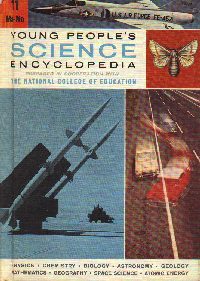 MARIJUANA (mah-ruh-HWAHN-uh) Marijuana is a habit-forming drug that over-excites people. It is against the law to use it. The drug is obtained from the leaves and flowers of the hemp plant. This plant is usually raised to obtain fibers for rope and other products. Indian hemp and similar plants have been known and used since ancient times.
MARIJUANA (mah-ruh-HWAHN-uh) Marijuana is a habit-forming drug that over-excites people. It is against the law to use it. The drug is obtained from the leaves and flowers of the hemp plant. This plant is usually raised to obtain fibers for rope and other products. Indian hemp and similar plants have been known and used since ancient times.
Marijuana, when used as a narcotic, is smoked as cigarettes. It is often associated with crime and other anti-social activities. A person under the influence of this drug suffers severe physical and mental effects starting with over-gaiety, talkativeness and feelings of grandeur. However, these feelings deteriorate into mental confusion, faulty speech and delirium.
The greatest danger in the use of marijuana is that it is known to lead its users into the use of even more violent and dangerous drugs. Most nations in the world have banded together in an attempt to ban the use and distribution of marijuana. The raising of the hemp plant is strictly regulated in the United States. H. J. C. - "(Helen J. Challand, B.E., M.A., Ph.D., Chairman, Science Department, National College of Education)
HEMP: Hemp is a plant that is used to make rope, twine, yarn, and paper products. It has long stems, from six to nine feet high. The stems are soaked in water and left outside to rot. Then they are crushed and beaten to separate the fibers from the other plant cells.
Hemp is an annual plant, grown from seed. Some plants produce pollen, or staminate, flowers, and others produce ova and are the ovulate flowers. Pollen flowers are yellowish-green. Ovulate flowers bloom later and are not so colorful. When the flowers die the stalks are cut down. Hemp plants need a wet, mild climate.
Hemp seeds contain oil used in paints and varnishes and in making soap. MARIJUANA, a dangerous drug, comes from the sap of the hemp plant. For this reason hemp growers in the United States must have a permit to cultivate the crop.
Manila hemp, or abaca, is not a true hemp. Manila rope has been made from abaca since the sailing ship days of the eighteen hundreds. Abaca fibers are tough and light and can be obtained in lengths from six to twelve feet. P. G. B. (Phyllis G. Blodgett, Free lance writing for Reader's Digest, Christian Science Monitor, Today's Health)
The New Illustrated Medical and Health Encyclopedia
H.S. Stuttman Co., Inc. Publishers New York 16, N.Y. 1964 Nelson Doubleday, Inc. Edited by Morris Fishbein, M.D.
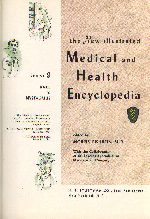
MARIHUANA, also known as hashish in the Orient, a habit-forming drug. It is the dried leaves and flower of the Indian hemp plant, usually smoked in cigarettes. Addiction to marihuana is as widespread in the United States as in other countries. Every country in Asia has a centuries long history of marihuana drug addiction.
The effects of marihuana have been recognized since the beginning of recorded history--an Assyrian medical tablet in the British Museum refers to hashish as "an intoxicant which cheers the spirits and sharpens the erotic impulse." Vivid descriptions of hashish debauches abound in ancient Arabian literature. Marco Polo in his description of his travels tells of the desperate band of Persian highwaymen, the Assassins, who initiated new members into their order by a licentious hashish carnival. It has even been suggested that the words assassin and hashish are derived from the same root.
Marihuana or hashish affects its users in many ways, since it stimulates the nervous, respiratory, circulatory, digestive, excretory, and genital systems. The drug clouds the mind and reduces self-control; the person becomes restless and talkative, relaxed and exhilarated with a sense of well-being, followed by drowsiness. Generally difficulty in focusing and sustaining mental attention is noted.
Because of its effect on the mind and on the body, marihuana, like alcohol, can be considered a dangerous drug. The addict usually requires psychiatric as well as medical care. For best results, hospital treatment is often advised. Serious withdrawal symptoms are not known to occur in the treatment of the marihuana addict, and complete, immediate abstinence from the drug may be effected. Treatment is similar to that of the chronic alcoholic.
Marihuana has long been a major problem for government narcotic squads, for the Indian hemp plant grows wild in many areas. Smoking the drug in the form of "reefers" has become increasingly prevalent. In 1934(sic), the United States Congress enacted legislation which prescribed almost as severe penalties for the use and sale of marihuana as for narcotics. See also DRUG ADDICTION.
[1970 Edition]
MARIHUANA, a milder form of hashish, a narcotic. It consists of the dried leaves and flowers of the Indian hemp plant, usually smoked in the form of cigarettes. The use of marihuana is widespread in the United States today.
The effects of marihuana have been recognized since the beginning of recorded history---an Assyrian medical tablet in the British Museum refers to hashish as "an intoxicant which cheers the spirits and sharpens the erotic impulse." Vivid description of hashish debauches abound in ancient Arabian literature. Marco Polo in his description of his travels tells of the desperate band of Persian highwaymen, the Assassins, who initiated new members into their order by a licentious hashish carnival. The words assassin and hashish are probable derived from the same root.
Marihuana or hashish affects its users in many ways, since it stimulates the nervous, respiratory, circulation, digestive, excretory, and genital systems. The drug clouds the mind and reduces self-control; the person becomes restless and talkative, relaxed and exhilarated with a sense of well-being, followed by drowsiness. Generally difficulty in focusing and sustaining mental attention is noted. Hallucinations may occur.
Marihuana has long been a major problem for government narcotic officials, for the Indian hemp plant grows wild in many areas. Smoking the drug in the form of "reefers" has become increasingly prevalent. In 1934(sic), the United States Congress enacted legislation which prescribed penalties for the use and sale of marihuana almost as severe as those for narcotics. The wisdom of this legislation has frequently been questioned by medical authorities, See also DRUG ADDICTION; MORPHINE AND OPIUM POISONING.
NEW MASTERS PICTORIAL ENCYCLOPEDIA
[1955 Edition]
MARIHUANA A weed or herb, growing in many parts of North America; the dried leaves of the plant, which have narcotic qualities when smoked in cigarettes; sometimes called the assassin of youth. - Marijuana, or Hashish, a subtle, crazing drug which is being surreptitiously sold in U.S. in the form of cigarettes. Narcotic officials named it 'The Assassin of Youth,' and state that it is as dangerous as a coiled rattlesnake. Its effects when smoked vary with different Individuals. It may make of its victim a philosopher, a joyous reveler, a mad insensate, or a fiendish murderer. Its purveyors whisper into the ears of Am. youth the wonders of a new cigarette with a real thrill, and without harmful effects. Students are lured to its use by promises of resultant keenness of mind, the easy solving of problems, an aid in exams. An addict was hanged in Baltimore in 1937 for a criminal assault on a ten-year-old girl. In Fla. a crazed youth killed his father, mother, two brothers, and a sister. In more than 30 cases of murder or degenerate sex crimes in 1937, marijuana proved to be a contributing cause.
THE AMERICAN EDUCATOR ENCYCLOPEDIA
[1959 Edition]
MARIJUANA: an intoxicating drug obtained from the hemp plant, Cannabis sativa. Its effects vary with the temperament of the user and the quantity used, but in general it may be said to break down inhibitions and thus open the way to unconventional and possibly criminal conduct. Marijuana is considered nonaddictive because users suffer no distress when denied access to it, but it might be considered habit-forming because in some cases there is an urge to continue using the drug. The possession and use of marijuana are proscribed under Federal laws and under the laws of many of the states. See also Narcotic.
HEMP: A fiber plant of the Mulberry family, native to central and western Asia. Hemp fibers do not deteriorate when wet, and so are often used to make ropes, carpet warp, carpet thread, sailcloth, bagging, and some types of paper. The ravelings obtained during the processing are known as oakum, which is used for calking and hydraulic packing (see Calking). Hempseed is used as birdseed, and is also used in making hashish and linoleum. Hemp seed oil is used in manufacturing paints, varnishes, and soaps.
The plants usually grow from five to twelve feet tall, but may reach twenty feet. The follow stalks, about the thickness of a lead pencil, bear slender handlike leaves with three to seven fingers. The small male and female flowers are borne on separate plants.
Hemp has been grown in china for centuries. It is also cultivated in Russia, Italy, Yugoslavia, and a few other European countries, as well as in Turkey, Japan, and the United States. In Kentucky, the most important hemp-growing area in the United States, cultivation of the plant began in the nineteenth century. Later, the production spread to California, Nebraska, Indiana, New York, and Wisconsin. When hemp imports declined during World War II, hemp was grown throughout the Corn Belt. Manila hemp is not a true hemp, but a member of the Banana family (see Manila Hemp). Similarly some other plants are called hemps.
Hemps grows best in rich, well-drained loam in areas with a five-month growing season. The seed is planted in rows by means of drills. Harvesting begins when the leaves start to yellow, usually after about three months. The crop is cut with a special harvester that lays the stalks in even rows on the ground.
After a month or two, dew, rain, and bacterial action have decomposed or retted the soft tissue surrounding the fibers. The bark is then easily removed. Fiber retted by water is usually soft and white, and is considered superior to the grayish fiber produced by dew retting. After the hemp has been bound by machine, it is placed in shocks for a few weeks to dry. It is then baled for market. See also Fiber; Marijuana; Mulberry.
The New People's Physician
[1941 Edition] - [Chapter 144 Drug Habits]
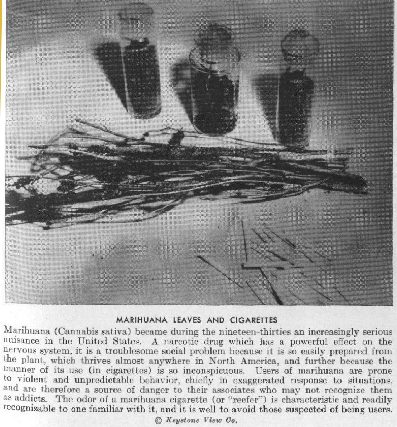 Cannabis indica or Indian hemp is taken in the East in the form of bhang, hashish, and other preparations. It produces a pleasant from of intoxication, but its effects are not so serious as those of the previously mentioned drugs. The American hemp is known as marihuana and smoking of the dried preparation of the drug is a fairly common addiction. The symptoms are similar to those of the Indian variety.
Cannabis indica or Indian hemp is taken in the East in the form of bhang, hashish, and other preparations. It produces a pleasant from of intoxication, but its effects are not so serious as those of the previously mentioned drugs. The American hemp is known as marihuana and smoking of the dried preparation of the drug is a fairly common addiction. The symptoms are similar to those of the Indian variety.
In many cases an individual begins to take the drug because he is so psychologically abnormal that he cannot face the realities of life. He takes the drug as a refuge from reality. . . .
The Universal World Reference Encyclopedia
[1945 Edition] [Pharmacology - Subsection]
. . . Cannabis, found in the hemp plant and made often into marihuana cigarettes, causes a narcotic effect upon the brain with symptoms of confusion, irritability, exaltation, and delirium. It is also habit-forming. . . . .
Funk and Wagnall Encyclopedia
[1986 Edition]
MARIJUANA, mixture of leaves, stems, and flowering tops of the Indian hemp plant Cannabis sativa, smoked or eaten for its hallucinogenic and pleasure-giving effects. The psychoactive ingredient of marijuana, tetrahydrocannabinol (THC), is concentrated in the flowering tops; hashish, a drug prepared from the plant resin, has about eight times more THC than marijuana. Marijuana grows throughout temperate regions, with the more potent varieties produced in dry, hot, upland climates. Except for limited medical purposes, cultivating marijuana is illegal in all but a few counties.
Known in Central Asia and China as early as 3000 BC, marijuana was used as a folk medicine. About 1900 it started to be used as a pleasure-inducing drug, and by the 1960;s and '70s its use was widespread among students, becoming, after alcohol, the second most popular drug. Although marijuana has not been proven to be physically addicting, and no physical withdrawal symptoms occur when its use is discontinued, psychological dependence does develop. Many users describe two phases of marijuana intoxication: initial stimulation, giddiness, and euphoria, followed by sedation and pleasant tranquility. Mood changes are often accompanied by altered perceptions of time and space and of one's bodily dimensions. The thinking processes become disrupted by fragmentary ideas and memories. Many users report increased appetite, heightened sensory awareness, and pleasure. Negative effects can include confusion, acute panic reactions, anxiety attacks, fear, a sense of helplessness, and loss of self-control.
Chronic marijuana users are said to develop an "amotivational syndrome" characterized by passivity, decreased motivation, and preoccupation with drugs talking. The relationship of this syndrome to marijuana use, however, has not been established. Like alcohol intoxication, marijuana intoxication impairs reading comprehension, memory, speech, problem-solving ability, and reaction time. The effects on the intellect of long-term use are unknown. Consistent evidence that marijuana induces or causes brain damage does not exist. Medical research has indicated that the drug is effective in relieving some of the symptoms of glaucoma (q.v.) and in treating the nausea induced by cancer chemotherapy and radiation treatments. P.A.B.
No attempt is made (nor even to suggest) that this listing covers ALL published encyclopedias during the Reefer Madness era. At best, it is but a small sampling of what was allowed to occur at the time.
ENCYCLOPEDIA'S OF EVIL
WANT TO KNOW MORE:
=====================
Due to space / download time considerations, only selected materials are displayed. If you would like to obtain more information, feel free to contact the museum. All our material is available (at cost) on CD-Rom format.
CONTACT PAGE